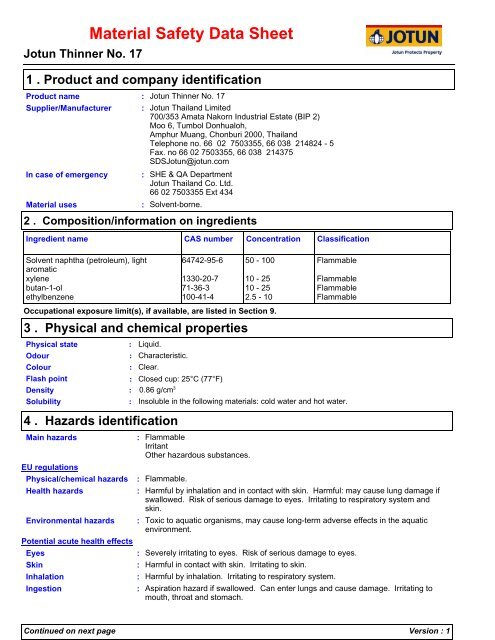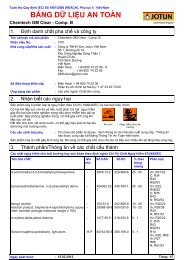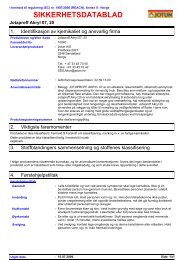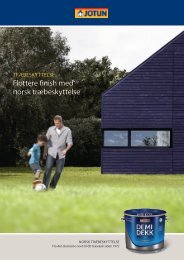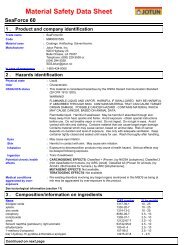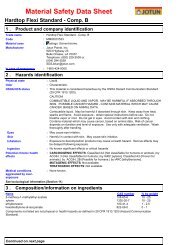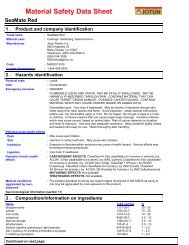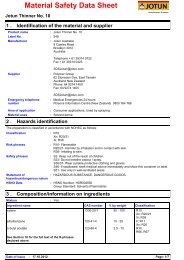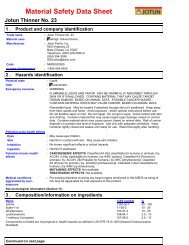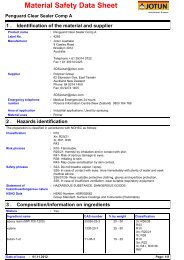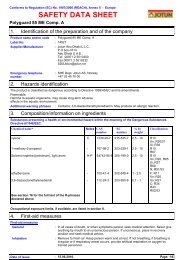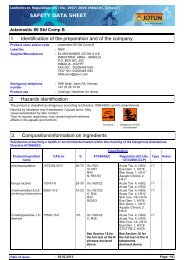SDS - Jotun Thinner No. 17 - Marine_Protective - English (uk
SDS - Jotun Thinner No. 17 - Marine_Protective - English (uk
SDS - Jotun Thinner No. 17 - Marine_Protective - English (uk
Create successful ePaper yourself
Turn your PDF publications into a flip-book with our unique Google optimized e-Paper software.
<strong>Jotun</strong> <strong>Thinner</strong> <strong>No</strong>. <strong>17</strong>Product nameMaterial Safety Data Sheet1 . Product and company identificationSupplier/ManufacturerIn case of emergencyMaterial uses:::<strong>Jotun</strong> <strong>Thinner</strong> <strong>No</strong>. <strong>17</strong><strong>Jotun</strong> Thailand Limited700/353 Amata Nakorn Industrial Estate (BIP 2)Moo 6, Tumbol Donhualoh,Amphur Muang, Chonburi 2000, ThailandTelephone no. 66 02 7503355, 66 038 214824 - 5Fax. no 66 02 7503355, 66 038 214375<strong>SDS</strong><strong>Jotun</strong>@jotun.comSHE & QA Department<strong>Jotun</strong> Thailand Co. Ltd.66 02 7503355 Ext 434: Solvent-borne.2 . Composition/information on ingredientsIngredient nameCAS numberConcentrationClassificationSolvent naphtha (petroleum), light 64742-95-6 50 - 100 Flammablearomaticxylene 1330-20-7 10 - 25 Flammablebutan-1-ol 71-36-3 10 - 25 Flammableethylbenzene 100-41-4 2.5 - 10 FlammableOccupational exposure limit(s), if available, are listed in Section 9.3 . Physical and chemical propertiesPhysical stateOdour :Colour :Flash point:Solubility::Liquid.Characteristic.Clear.Density : 0.86 g/cm 34 . Hazards identificationMain hazardsEU regulationsPhysical/chemical hazardsHealth hazardsEnvironmental hazardsPotential acute health effectsEyesSkinInhalationIngestion:::::Closed cup: 25°C (77°F)Insoluble in the following materials: cold water and hot water.FlammableIrritantOther hazardous substances.: Flammable.: Harmful by inhalation and in contact with skin. Harmful: may cause lung damage ifswallowed. Risk of serious damage to eyes. Irritating to respiratory system andskin.: Toxic to aquatic organisms, may cause long-term adverse effects in the aquaticenvironment.Severely irritating to eyes. Risk of serious damage to eyes.Harmful in contact with skin. Irritating to skin.Harmful by inhalation. Irritating to respiratory system.Aspiration hazard if swallowed. Can enter lungs and cause damage. Irritating tomouth, throat and stomach.Continued on next page Version : 1
<strong>Jotun</strong> <strong>Thinner</strong> <strong>No</strong>. <strong>17</strong> Page: 3/6Storage: Store in accordance with local regulations.<strong>No</strong>tes on joint storageKeep away from: oxidising agents, strong alkalis, strong acids.Additional information on storage conditionsObserve label precautions. Store in a dry, cool and well-ventilated area. Keep away fromheat and direct sunlight. Keep away from sources of ignition. <strong>No</strong> smoking. Preventunauthorised access. Containers that have been opened must be carefully resealed andkept upright to prevent leakage.9 . Exposure controls/personal protectionEngineering measures :Occupational exposure limitsProvide adequate ventilation. Where reasonably practicable, this should be achieved bythe use of local exhaust ventilation and good general extraction. If these are notsufficient to maintain concentrations of particulates and solvent vapours below the OEL,suitable respiratory protection must be worn.Ingredient nameExposure limitsSolvent naphtha (petroleum), light aromatic ACGIH TLV (United States, 1/2005).TWA: 123 mg/m³ 8 hour(s). Form: All formsTWA: 25 ppm 8 hour(s). Form: All formsxylene Ministry of Interior (Thailand, 7/1977).TWA: 435 mg/m³ 8 hour(s).TWA: 100 ppm 8 hour(s).butan-1-ol ACGIH TLV (United States, 2/2010).TWA: 20 ppm 8 hour(s).ethylbenzeneACGIH TLV (United States, 1/2008). <strong>No</strong>tes:KTWA: 100 ppm 8 hour(s). Form:STEL: 125 ppm 15 minute(s). Form:Personal protective equipmentRespiratory system :Skin and bodyHands :Eyes :10 . Stability and reactivity:Use a properly fitted, air-purifying or air-fed respirator complying with an approvedstandard if a risk assessment indicates this is necessary. Respirator selection mustbe based on known or anticipated exposure levels, the hazards of the product andthe safe working limits of the selected respirator.Personnel should wear antistatic clothing made of natural fibres or of high-temperatureresistantsynthetic fibres.For prolonged or repeated handling, use the following type of gloves: gloves: polyvinylalcohol or nitrile.Barrier creams may help to protect the exposed areas of the skin but should not beapplied once exposure has occurred.For right choice of glove materials, with focus on chemical resistance and time ofpenetration, seek advice by the supplier of chemical resistant gloves.Use safety eyewear designed to protect against splash of liquids.Stable under recommended storage and handling conditions (see section 7).Hazardous decomposition products: carbon monoxide, carbon dioxide, smoke, oxides of nitrogen.Keep away from the following materials to prevent strong exothermic reactions: oxidising agents, strong alkalis, strong acids.Continued on next page Version : 1
<strong>Jotun</strong> <strong>Thinner</strong> <strong>No</strong>. <strong>17</strong> Page: 4/611 . Toxicological informationThere are no data available on the preparation itself. The preparation has been assessed following the conventionalmethod of the Dangerous Preparations Directive 1999/45/EC and classified for toxicological hazards accordingly. Seesections 2 and 15 for details.Exposure to component solvent vapour concentrations in excess of the stated occupational exposure limit may result inadverse health effects such as mucous membrane and respiratory system irritation and adverse effects on the kidneys,liver and central nervous system. Symptoms and signs include headache, dizziness, fatigue, muscular weakness,drowsiness and, in extreme cases, loss of consciousness.Solvents may cause some of the above effects by absorption through the skin. Repeated or prolonged contact with thepreparation may cause removal of natural fat from the skin, resulting in non-allergic contact dermatitis and absorptionthrough the skin.If splashed in the eyes, the liquid may cause irritation and reversible damage.Ingestion may cause nausea, diarrhea and vomiting.This takes into account, where known, delayed and immediate effects and also chronic effects of components from shorttermand long-term exposure by oral, inhalation and dermal routes of exposure and eye contact.Risk of serious damage to eyes.12 . Ecological informationThere are no data available on the preparation itself.Do not allow to enter drains or watercourses.The preparation has been assessed following the conventional method of the Dangerous Preparations Directive 1999/45/ECand is classified for eco-toxicological properties accordingly. See Sections 2 and 15 for details.EcotoxicityProduct/ingredient name ResultSpeciesExposureethylbenzene Acute EC50 7,2 mg/L Algae 48 hoursAcute EC50 2,93 mg/L Daphnia 48 hoursAcute LC50 4,2 mg/L Fish 96 hoursSolvent naphtha (petroleum), Acute EC50
<strong>Jotun</strong> <strong>Thinner</strong> <strong>No</strong>. <strong>17</strong> Page: 5/614 . Transport informationTransport within user’s premises: always transport in closed containers that are upright and secure. Ensure thatpersons transporting the product know what to do in the event of an accident or spillage.International transport regulationsPaint related materialProper shipping name :<strong>Marine</strong> pollutantsubstancesUN number : 1263Class : 3Packing group: IIILabel ::Solvent naphtha (petroleum), light aromaticMarking :The environmental hazardous / marine pollutant mark is only applicable for packagescontaining more than 5 litres for liquids and 5 kg for solids.Additional informationADR / RIDIMDG: Tunnel restriction code: (D/E)Hazard identification number: 30Special provisions: 640E: Emergency schedules (EmS): F-E, S-E<strong>Marine</strong> pollutant: Yes.Transport in accordance with ADR/RID, IMDG/IMO and ICAO/IATA and national regulation.15 . Regulatory informationNational regulationsHazardous Substance Act B.E. 2535 (1992)Classification: FlammableIrritantOther hazardous substances.UN hazard symbols :EU regulationsHazard symbol orsymbols:HarmfulDangerous for theenvironmentContains: Solvent naphtha (petroleum), light aromaticxyleneRisk phrases : R10- Flammable.R20/21- Harmful by inhalation and in contact with skin.R65- Harmful: may cause lung damage if swallowed.R41- Risk of serious damage to eyes.R37/38- Irritating to respiratory system and skin.R51/53- Toxic to aquatic organisms, may cause long-term adverse effects in theaquatic environment.Continued on next page Version : 1
<strong>Jotun</strong> <strong>Thinner</strong> <strong>No</strong>. <strong>17</strong> Page: 6/6Safety phrasesUS regulationsHCS Classification16 . Other informationCEPE Classification : 1<strong>No</strong>tice to readerHistoryDate of printingDate of issueDate of previous issueVersionPrepared by:S2- Keep out of the reach of children.S23- Do not breathe vapour / spray.S26- In case of contact with eyes, rinse immediately with plenty of water and seekmedical advice.S29- Do not empty into drains.S36/37/39- Wear suitable protective clothing, gloves and eye/face protection.S46- If swallowed, seek medical advice immediately and show this container or label.S51- Use only in well-ventilated areas.: Flammable liquidCarcinogenTarget organ effects:::::<strong>17</strong>.10.2012.<strong>17</strong>.10.2012.<strong>No</strong> previous validation.1<strong>Jotun</strong> Group Product Safety DepartmentThe information in this <strong>SDS</strong> is based on the present state of our knowledge and on current laws. The product is not to be usedfor purposes other than those specified under section 1 without first obtaining written handling instructions. It is always theresponsibility of the user to take all necessary steps to fulfil the demands set out in the local rules and legislation. Theinformation in this <strong>SDS</strong> is meant to be a description of the safety requirements for our product. It is not to be considered aguarantee of the product's properties.Indicates information that has changed from previously issued version.Page: 6/6Version1


